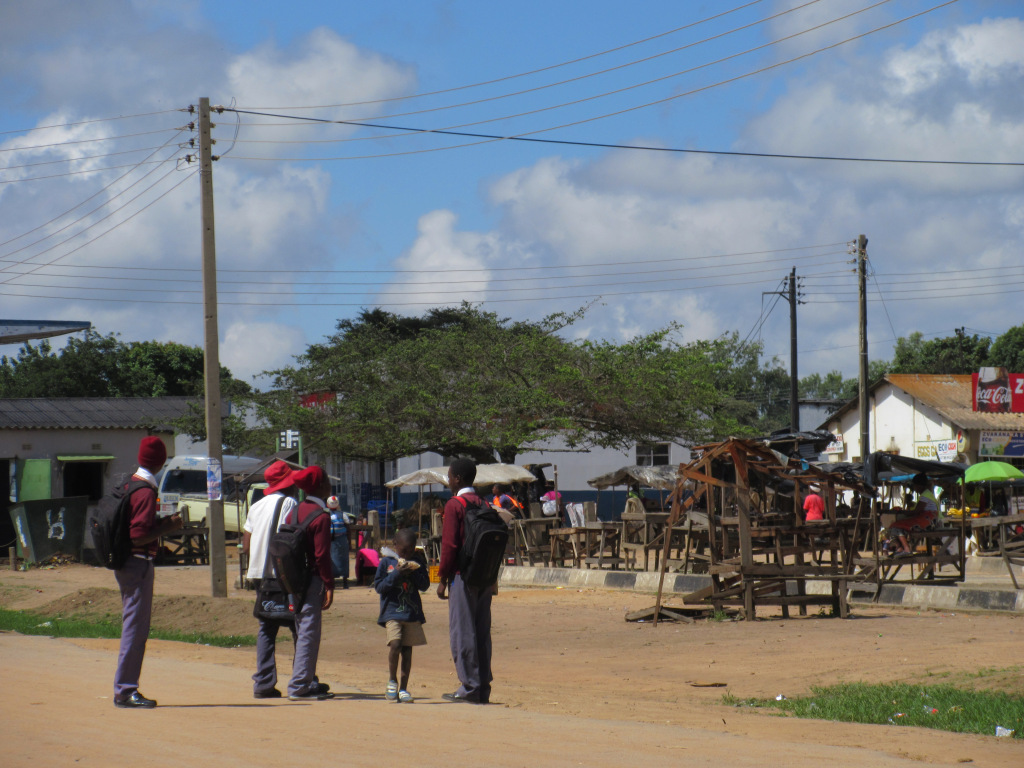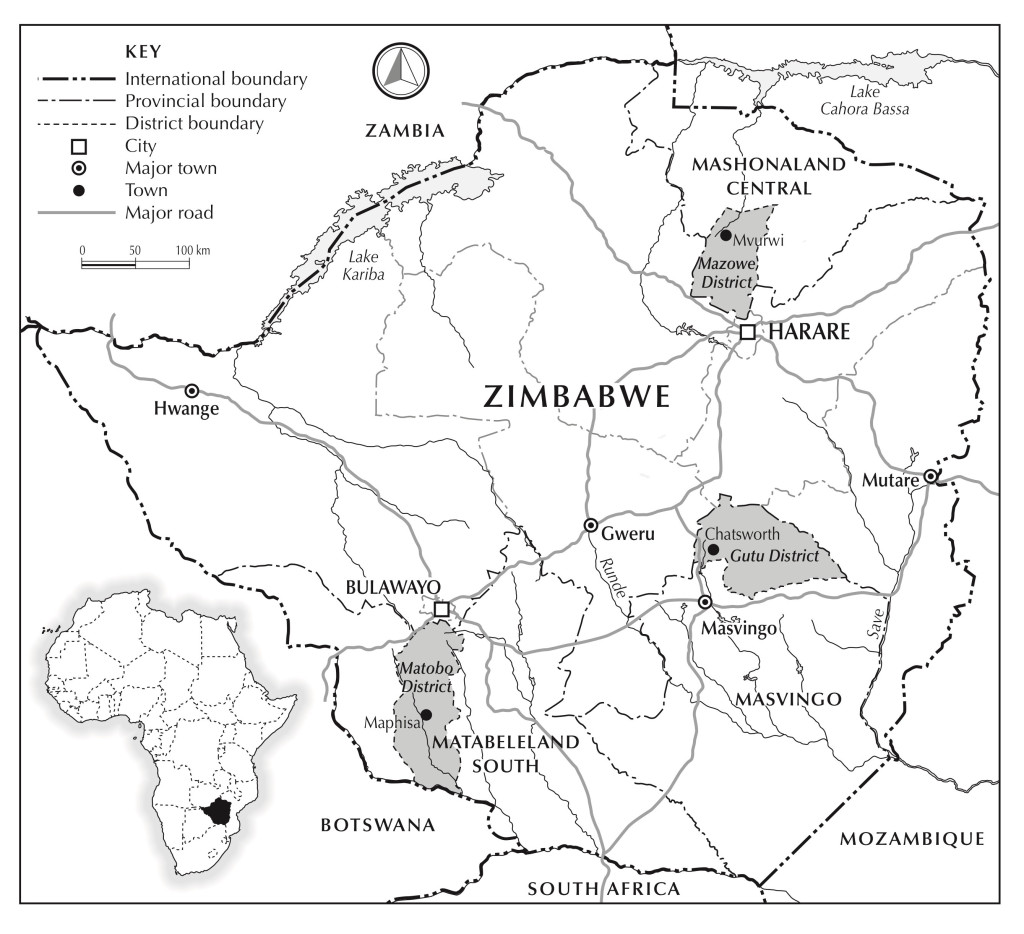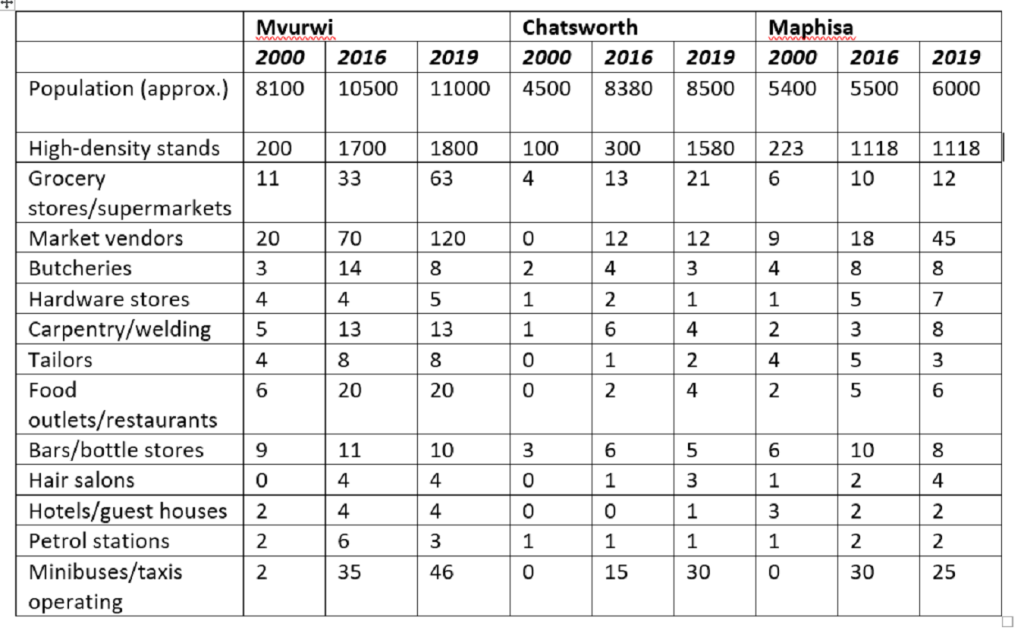
This post was written by Ian Scoones and first appeared on Zimbabweland
Our recent paper – small towns and land reform in Zimbabwe – out in the European Journal of Development Research (open access) – explores some of the themes discussed last time for the Zimbabwe setting.
Over a number of years, we have been monitoring changes in three small towns in Zimbabwe, situated in different parts of the country (see map below).

The results point to a major growth in population, building and business activity (see Table below). This is substantially driven by a reconfigured local economy, with production from smallholder farming land reform areas (A1 resettlements) contributing to this.

Mvurwi’s growth has been driven by the tobacco boom following land reform, while Chatsworth has benefited from the growth of maize and vegetable production, but also the presence of popular churches in the area. Maphisa has grown thanks the cattle and mining economy, which is now more locally-rooted involving many land reform farmers.
Although contingent and context dependent, the changes that have occurred in each of the small towns can be summarised across four themes. The following sections are much-abbreviated extracts from the EJDR paper.
Business opportunities
The expansion of small- and medium-scale agriculture since land reform has resulted in income from agricultural surpluses being circulated locally, especially from A1 smallholder farms. This includes cash from sales of tobacco (Mvurwi), maize/horticulture (Chatsworth) and livestock (Maphisa). In Maphisa in particular this agricultural income is complemented by money from small-scale gold mining. This is generating demand for services, as well as opportunities for the sale of produce. Compared to the pre-land reform situation, there are many more businesses of all types in all three towns. There are five times as many hardware stores, four times as many grocery stores and food outlets, three times as many butcheries, double the number of bottle stores and bars, and five times more informal vendors. Transport has become a vital business linking the town with the wider agricultural hinterland.
Demography and difference: new people in town
In the last 20 years, populations have more than tripled; and this is just the permanent population, and not those who commute back and forth from the rural areas. Today there are new people in town. In Mvurwi in particular, former workers in commercial farms no longer have jobs on farms and have had to seek alternatives. Some have left, but many have stayed and become engaged in supporting new forms of local agriculture and become involved in town based business activities. Women and young people are especially important players in the new informal economy of these small towns. Women, for example, may be married to a man who received land through the land reform and will assist at the family farm, but also will be involved in trading businesses in town. Young people are often without land, missing out on land reform in 2000, but may live at home with their parents but run a business in the nearby town. Moving small distances, seasonally or daily, is the new pattern, with multi-locational households and multiplex livelihoods the norm.
Rural-urban social relationships and networks
Land reform has created new rural-urban connections. In the past, the rural town was quite disconnected from the large-scale commercial farming operation, beyond being the source of labour and providing some inputs and services. Today such small towns are intimately linked in a much tighter, more integrated local economy. There are relations from rural to urban (marketing of produce, movement of people) and from urban to rural (supplies of labour, inputs, services and provision of transport). These linkages are fostered through social relationships, which have to be invested in. Making sure that a vending business in town thrives requires the vendor to have good relationships with suppliers in the nearby resettlement areas, with transporters to ferry goods to town, with council officials who collect rates and inspect premises and the police who invariably are looking for a bribe. Having a rural home nearby to return to is important, and today the rural areas surrounding these towns are now full of farms and people. Keeping close to ‘home’ – even if you do not have land – remains crucial, and the ability to be mobile and opportunistic is vital in the face of economic uncertainty, especially for young people.
Planning, politics and governance
While there has been a building boom across the sites, generating opportunities for brick-makers, hardware suppliers, transporters and builders, the wider public infrastructure of all three small towns is in a poor state. The state has not invested significantly in basic maintenance and expansion of roads, sewage systems or electricity supply in these fast-expanding towns. The failure of the state (local and national) to provide for basic services and infrastructure in rural and urban areas is a source of deep resentment, especially when high-profile expenditures and rampant corruption are highlighted. The standard, divided approach to urban administration and governance makes little sense, as people straddle urban and rural areas. With new interest groups and associated power relations, the politics of the urban-rural nexus after land reform has become highly contested, with a new rural-urban politics emerging. How this translates into reformed administrative and governance arrangements for small towns and associated rural areas remains a major challenge in Zimbabwe, as elsewhere.
Rethinking rural-urban development
As with the AGRA report discussed in the last blog, our paper concludes with a focus on ‘territorial development’:
“[The] post-land reform rural-urban configuration means going beyond a separated town and countryside focus to a wider spatial, territorial perspective, looking at sites of accumulation across rural and urban spaces, and the connections between them, focusing on how social and political relations and governance arrangements are able to support these. Small towns in this sense offer a window onto a new set of economic, social and political relations at the heart of Zimbabwe’s new agrarian landscape, and must be central to territorially-focused, regionally-connected local economic development efforts into the future”.
As a consequence, development priorities must change. As we note, “feeder roads to rural areas become important, as does the provision low-cost and safe market stands and temporary accommodation for mobile traders and business people. Equally taking account of the changing demographic composition of small towns in important, “with the need to provide safety and security for young and female mobile populations, who are essential to the urban economy often without permanent homes in town.”
More broadly, assumptions of a simple linear ‘structural transformation’ in development – from rural to urban, from agriculture to industry, from small to larger scale – is challenged. A focus on the spatial relationship of local economies and food systems, and the territorial connections across rural and urban spaces, suggests that such transformations are much more complex. With a redistribution of land through the post 2000 land reform and the growth of especially smallholder agriculture that resulted, a very different, unexpected trajectory has emerged, more embedded in local territories, with integrated links between agriculture and urban enterprise.
As Zimbabwe continues to contemplate its post-land reform transition, a focus on small towns and the links to wider rural production systems must be central. The next blog updates the story in the context of the pandemic where decentralisation of business operations to small towns has become essential.
